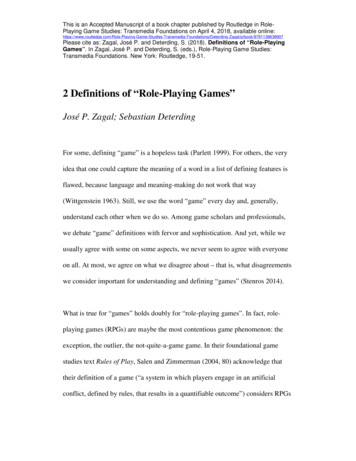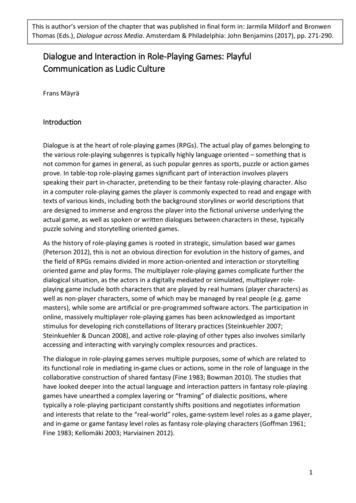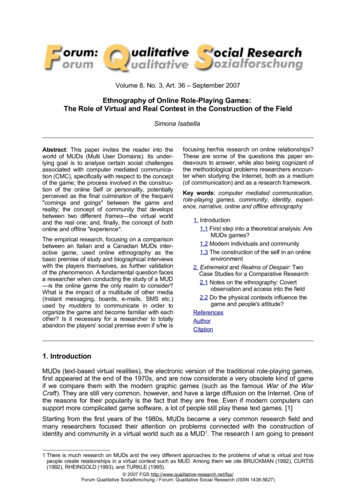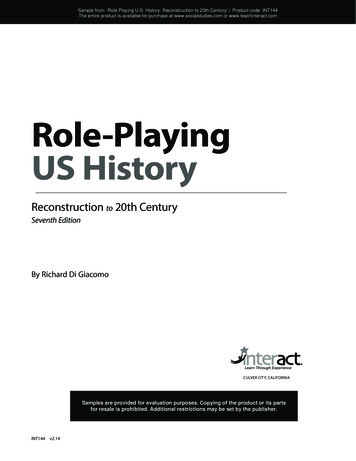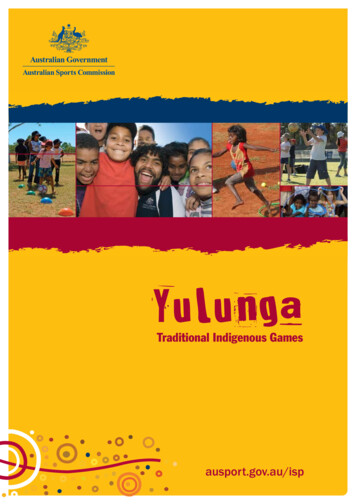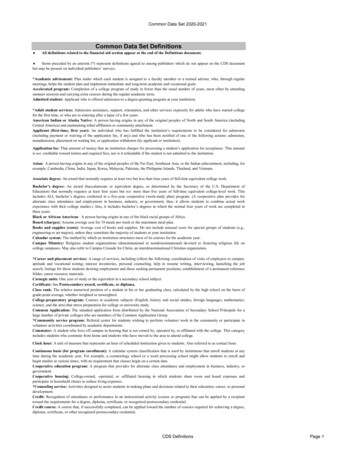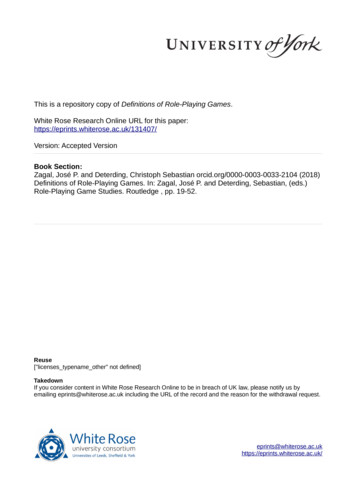
Transcription
This is a repository copy of Definitions of Role-Playing Games.White Rose Research Online URL for this on: Accepted VersionBook Section:Zagal, José P. and Deterding, Christoph Sebastian orcid.org/0000-0003-0033-2104 (2018)Definitions of Role-Playing Games. In: Zagal, José P. and Deterding, Sebastian, (eds.)Role-Playing Game Studies. Routledge , pp. 19-52.Reuse["licenses typename other" not defined]TakedownIf you consider content in White Rose Research Online to be in breach of UK law, please notify us byemailing eprints@whiterose.ac.uk including the URL of the record and the reason for the withdrawal terose.ac.uk/
2 Definitions of “Role-Playing Games”José P. Zagal; Sebastian DeterdingFor some, defining “game” is a hopeless task (Parlett 1999). For others, the very idea that one could capturethe meaning of a word in a list of defining features is flawed, because language and meaning-making do notwork that way (Wittgenstein 1963). Still, we use the word “game” every day and, generally, understand eachother when we do so. Among game scholars and professionals, we debate “game” definitions with fervor andsophistication. And yet, while we usually agree with some on some aspects, we never seem to agree witheveryone on all. At most, we agree on what we disagree about – that is, what disagreements we considerimportant for understanding and defining “games” (Stenros 2014).What is true for “games” holds doubly for “role-playing games”. In fact, role-playing games (RPGs) aremaybe the most contentious game phenomenon: the exception, the outlier, the not-quite-a-game game. In theirfoundational game studies text Rules of Play, Salen and Zimmerman (2004, 80) acknowledge that theirdefinition of a game (“a system in which players engage in an artificial conflict, defined by rules, that resultsin a quantifiable outcome”) considers RPGs a borderline case. While RPGs are widely recognized for theirinfluence on many other games (e.g. Tychsen 2006), they are apparently not game enough because they lack aquantifiable outcome (Salen and Zimmerman 2004, 81). Jesper Juul, author of another influential gamedefinition, likewise considers tabletop RPGs a borderline case: they are “not normal games because with ahuman game master, their rules are not fixed beyond discussion” (Juul 2003).To make matters worse, “role-playing games” refers to a plurality of forms across media – there are tabletopRPGs, computer RPGs, (massively) multiplayer online RPGs, live-action RPGs, and more. Do these differentforms have ‘enough’ in common to all be called “role-playing games”? Furthermore, there are many differentcommunities discussing the definition of “role-playing games”, each with different practical ends: gamedesigners and publishers use the word in game manuals, sales venues, trade publications and conference talksto set consumer expectations and discuss design issues; fans discuss RPGs in fan media; scholars discussRPGs in the contexts of research and teaching. RPG fans and designers have long observed the existence of1
quite different styles and ends of playing RPGs – focusing e.g. on storytelling, playing a role, simulating aworld, or achieving goals and progress according to rules (see chapter 10). This openness to divergentpreferences and enactments seems characteristic for RPGs. For instance, different cultural regions havedeveloped distinct flavors like “Nordic larp” (Stenros and Montola 2010). Existing forms are constantlyremade and redefined by avant-garde movements like “indie” tabletop RPGs. What’s more, game research isitself notoriously multidisciplinary, looking at games – and RPGs – through many different theoretical anddisciplinary lenses (Deterding 2016).Box insert 2.1: Sample definitions of role-play“A role-playing situation is here defined as a situation in which an individual is explicitly asked to take a rolenot normally his own, or if his own in a setting not normal for the enactment of the role.” (Mann 1956, 227)Role-play is “not a single well-defined activity but a whole species of activities grouped under a convenientname. At one end of the spectrum is the intensive ‘acting out’ of personal emotions. At the other is thesituation where ‘taking the part’ is closer to the concept of advocacy” (van Mentz 1981, 27-28).“a media, where a person, through immersion into a role and the world of this role, is given the opportunityto participate in and interact with the contents of this world.” (Henriksen 2002, 44)“roleplaying is the art of experience, and making a roleplaying game means creating experiences”(Pettersson 2006, 101)“1) Role-playing is an interactive process of defining and re-defining the state, properties and contents of animaginary game world.2) The power to define the game world is allocated to participants of the game. The participants recognize theexistence of this power hierarchy.3) Player-participants define the game world through personified character constructs, conforming to thestate, properties and contents of the game world. [.]I also present four optional, additional rules that often complement the first three rules. [.]i) Typically the decisive power to define the decisions made by a free-willed character construct is given tothe player of the character.2
ii) The decisive defining power that is not restricted by character constructs is often given to peopleparticipating in referee roles.iii) The defining process is often governed by a quantitative game ruleset.iv) The information regarding the state of the game world is often disseminated hierarchically, in a fashioncorresponding with the power structure of the game. [.]Additionally, these three endogenous rules [.] differentiate certain forms of role-playing from each other:t1) In tabletop role-playing the game world is defined predominantly in verbal communication.l1) In larp the game is superimposed on physical world, which is used as a foundation in defining the gameworld.v1) In virtual role-playing the game is superimposed on a computational virtual reality, which is used as afoundation in defining the game world.” (Montola 2009, 23-24)“Role-playing is immersion to an outside consciousness (‘a character’) and interacting with itssurroundings” (Pohjola 2003,34)“Role-playing is immediated character immersion” (Pohjola 2004, 89)“role-playing is defined as any act in which an imaginary reality is concurrently created, added to andobserved” (Mäkelä et al. 2005, 207)Different forms, communities, design and play styles, cultures, historical moments, disciplines: all thesecontribute to the difficulty of defining “role-playing games”. Yet we believe that a crucial reason why peoplehaven’t been able to settle on a shared definition is the – largely unreflected – way in which they have tried todo so. For as linguistics and philosophy tell us, there are many ways of defining things, some outmoded, manyonly appropriate for specific purposes, and all laden with consequential assumptions, decisions, and implicitvalues.To clarify the definitions of “role-playing games”, we therefore first survey the different forms andunderstandings of definitions. We argue that how scholars have traditionally tried to define “role-playinggames” – as a presumed unchanging ‘essence’ consisting of a set of shared features – is at odds with what weknow about language and meaning-making, and with the kind of phenomena “role-playing games” refer to.3
We present an alternative pragmatist position that allows for a plurality of definitions as explicit (disciplinary)perspectives and tools. We then proceed with what we identify as a useful task for disciplinary-spanningwork: clarifying discourse by empirically describing who is using the word “role-playing games” how. We doso by discussing four commonly distinguished forms of RPGs: tabletop, live-action, single-player computer,and multiplayer online RPGs. For each, we tease out: how they have been defined by scholars, designers, and fans, as these are the three main social groupsproducing and circulating definitions; what empirical phenomena these groups have pointed at with the word “role-playing games” and whatcharacteristics reoccur across these phenomena; where these characteristics historically originated; and how they evolved over time and what kind of variation we see.Finally, we tease out common characteristics across forms of RPGs, as well as characteristics of the discourseabout them. We argue that joint ancestry in early tabletop RPGs can explain at least part of the sharedcharacteristics of the things people call “role-playing games”. The divergence of multiple forms of RPGs inturn stems from the affordances of their socio-material assemblages: what form of play they make easy orhard to accomplish. Because RPGs are social not natural entities and relatively underdetermined, they showsuch a wide and growing diversity of forms and play styles.Box insert 2.2: Sample definitions of role-playing games“any game which allows a number of players to assume the roles of imaginary characters and operate withsome degree of freedom in an imaginary environment” (Lortz 1979, 36, as cited in Fine 1983, 6)“role-playing has a lot more common with novels that it does with games. [ ] A role-playing game is, in fact,an improvised novel in which all the participants serve as authors.” (Swan 1990, 3)“A role-playing game must consist of quantified interactive storytelling”: character abilities and actionresolution are “defined by numbers or quantities . manipulated following certain rules”; “player decisionmaking drives the story forward”; “with a group for an author, a story that grows organically and is actedout, is experienced by its creators” (Schick 1991, 10-11).4
“Allows people to become simultaneously both the artists who create a story and the audience who watchesthe story unfold. This story has the potential to become a personal myth, shaped to meet the needs of itscreators.” (Padol 1996)“an episodic and participatory story-creation system that includes a set of quantified rules that assist a groupof players and a gamemaster in determining how their fictional characters’ spontaneous interactions areresolved. These performed interactions between the players’ and the gamemaster’s characters take placeduring individual sessions that, together, form episodes or adventures in the lives of the fictional characters”(Mackay 2001, 4–5)“what is created in the interaction between players or between player(s) and gamemaster(s) within aspecified diegetic framework. [.] [A] roleplaying game requires four things, a gamemaster, a player,interaction, and a diegetic framework.” (Stenros and Hakkarainen 2003, 61)“1. Game World: A role-playing game is a game set in an imaginary world. Players are free to choose how toexplore the game world, in terms of the path through the world they take, and may revisit areas previouslyexplored. The amount of the game world potentially available for exploration is typically large.2. Participants: The participants in the games are divided between players, who control individualcharacters, and referees (who may be represented in software for digital examples) who control theremainder of the game world beyond the player characters. Players affect the evolution of the game worldthrough the actions of their characters.3. Characters: The characters controlled by players may be defined in quantitative and/or qualitative termsand are defined individuals in the game world, not identified only as roles or functions. These characters canpotentially develop, for example in terms [of] skills, abilities or personality, the form of this development is atleast partially under player control and the game is capable of reacting to the changes.4. Game master: At least one, but not all, of the participants has control over the game world beyond a singlecharacter. A term commonly used for this function is “game master”, although many others exist. Thebalance of power between players and game masters, and the assignment of these roles, can vary, even withinthe playing of a single game session. Part of the game master function is typically to adjudicate on the rules ofthe game, although these rules need not be quantitative in any way or rely on any form of random resolution.5
5. Interaction: Players have a wide range of configurative options for interacting with the game worldthrough their characters, usually including at least combat, dialogue and object interaction. While the rangeof options is wide, many are handled in a very abstract fashion. The mode of engagement between player andgame can shift relatively freely between configurative and interperative.6. Narrative: Role-playing games portray some sequence of events within the game world, which gives thegame a narrative element. However, given the configurative nature of the players’ involvement, theseelements cannot be termed narrative according to traditional narrative theory” (Hitchens and Drachen 2009,16)“1. Game World: There is a game world, which is defined at least partially in the act of role-playing. Thisgame world is at least partially separate from the players ordinary life, and exists within a magic circle ofplay.2. Participants: There are more than one participant, which may include computers.3. Shared Narrative Power: More than one player can alter the narrative, or it is not role-playing, butstorytelling. Shared narrative power implies narrative.4. Interaction: There are varying modes of interaction with the game world. Conventions of play influencethese forms of interaction, limiting the scope (What can I change in the game world?) and modes (How can Ichange it?) of interaction.” (Arjoranta 2011, 14)“An RPG is a game, not a game system or product, but a game experience that that a player plays, in whichthe player portrays a character in a setting. Each player’s portrayal of their character must include threecomponents: immersion, experiencing the character; acting, performing in character; and gaming, obeyingand manipulating rules and goals in character.” (Simkins 2015, 56)Defining “definitions”Definitions are usually seen to state the reference and meaning of a word or concept, to specify its extensionand intension (Baumann 2002). Extension is the set of phenomena a word refers to, e.g., “game” refers to allthe actual games that exist. Intension is the meaning of the word stated as a set of properties all and onlyinstances of that essence share – e.g., what is the “heart of gameness” (Juul 2003) that makes all gamesgames? What list of properties allows us to tell whether something counts as a game?6
Definitions in game studies usually align with this tradition, taking the form “X is a Y with the properties Z1,Z2, , Zn”, e.g. “a game [X] is a system [Y] in which players [Z1] engage in an artificial conflict [Z2],defined by rules [Z3], that results in a quantifiable outcome [Z4].” (Salen and Zimmerman 2004) Thisclassical conception of definitions – dating to Aristotle and Plato – is sometimes called a genus-differentiadefinition, because it defines X as a specific kind of a larger category or genus (here: a system) that is distinctfrom other kinds in this category by some differentiating properties or differentia (here: players, artificialconflict, etc.) (Margolis and Laurence 2014; Gupta 2015). Although intuitive, there is significant evidence inpsychology and linguistics that concepts and words do not work as the classical conception suggests(Baumann 2002; Margolis and Laurence 2014).Scholars have proposed numerous alternatives (see Margolis and Laurence 1999 for a collection).Wittgenstein (1963) for instance held that there is no set of necessary and sufficient properties shared by alland only those phenomena people call “games”. This was not a statement specific to games. Rather,Wittgenstein used games as an example for a general argument about language and meaning. Wittgenstein’sfamily resemblance model argues that each thing a word refers to shares many properties with other thingsthat word refers to, but no such properties are shared by all and only those things. Given this plurality oftheories of concepts and their meanings, each with varying support, any scholarly definition should, withreason, be able to state which theory it subscribes to and why. Yet most current definitions of RPGs don’t.Which brings us to a second unspoken assumption: What kind of definition are we making? To mentioncommon distinctions (Gupta 2015): There are stipulative definitions, used to introduce a new concept (e.g.“zlorch is a unit of X”) or clarify the use of an existing one, e.g. “I here use ‘game’ to mean any conflictbetween two or more parties”. Nominal definitions try to capture the meaning and use of a word (as done in adictionary), and real definitions try to capture the properties of the phenomena the word refers to. Closelylinked to that is the anthropological distinction between emic and etic accounts (Headland, Pike, and Harris1990): Emic accounts state the views, concepts, understandings of a given culture: “these people call thesethings RPGs”. Etic accounts present views and concepts of the observing researcher: “they call these ‘RPG’s,but I call them ‘socially-focused play experiences’”. So, when examining existing definitions, it is importantto understand what kind of definition is being proposed and what purpose it is attempting to serve.7
A third assumption: Of what “stuff” are concepts, words, and the things they refer to made? The two mostrelevant considerations for our purposes are whether role-playing games are natural or social entities, andconnected to that, whether they are natural kinds. Natural entities are things described by the natural sciences,like bees, quasars, or magnetism, and seen to exist independent of human action and meaning-making.Natural kinds are groupings of natural entities that reflect the structure of the natural world rather than thestructure of human interests, actions, and understandings (Bird and Tobin 2015). In contrast, social entitieslike divorce, crime, or money are brought into existence by human action and meaning-making (e.g. Searle1995). For instance, chemical elements like gold and silver are natural kinds that show the same observableproperties in every context, whereas what counts as a “precious metal” and what can be done with it dependson local social contexts of human action and meaning.This doesn’t mean that social entities are “less real” or “less sturdy” than natural entities. Just like chemistrydescribes the chemical processes through which hydrogen and oxygen combine to produce water, the socialsciences describe the social processes – how people act, talk, and shape their material environment – thatproduce the sturdy entities we call “government”, “money”, or “crime” (Hacking 1999). Because theseentities are made of social processes, scientific description can affect the entities described: a psychologistdefining a behavior as “mental illness” and classifying someone as “having” that illness affects how weunderstand and treat that person. With natural kinds, whether something belongs to that kind can be settledempirically. With social categories, whether something belongs to it is determined by the agreement of thatsociety’s actors. A social category is its practical use (Bowker and Star 2000). As a result, social entitiesexhibit historical change and cultural variation: Swedes and Japanese may consider what is “embarrassing”different from each other as well as their ancestors from 100 years ago.The point is that some game definitions imply that “games” are a natural kind while a number of gamescholars have recently argued that games are social (or socio-material) entities (Montola 2012; Deterding2014; Stenros 2015). Arguably, RPGs foreground this social constitution of games. In TRPGs and larp, it isreadily apparent that people talk and act a given game and game world into being – when people stop enactingit, the game ceases to exist. In contrast, board games continue to exist as physical objects people can point toand call “game” even when the game is not being played. Defining games as social entities implies that they8
are subject to historical change and cultural difference. Thus, game definitions can only tease out “what gamesare” for a given social group at a given point in time. It also means that we have to specify what social entitythey are. The word “role-playing games”, like “games”, is used to denote both objects and activities (Hitchensand Drachen 2009). There has been an analogous split between definitions of role-play and definitions of roleplaying games (ibid.).Any definition is always an abstraction: the map, not the territory. As such, it foregrounds certain aspects asrelevant and ignores or de-emphasizes others. What is considered as relevant is always informed by somehuman concern. As Bateman (2015) pointed out with regard to game definitions, “every definition marks outsome subset of phenomena as being of specific interest to its topic and thus involves some kind of valuejudgment”. This leads to another unspoken assumption of most definitions: From what (disciplinary)perspective are we looking at the phenomenon in question?Now to some extent, academic disciplines are constituted by what they consider worthy of concern. Thisconcern informs what their theories look like, how the world appears to them – and consequently, what endsup being the starting term or genus of their definitions. An economist is concerned with how goods andservices are produced, distributed, and consumed. So, when asked to define “role-playing games”, she mightstate: “It is a good, specifically, an entertainment/hedonic/experiential good with the properties x, y, z”, or “itis an economy, specifically a virtual economy” (see chapter 16). To an educational researcher – concernedwith human learning – role-playing games would appear (and be defined) as a specific site or form of learning(see chapter 15). The fact that current popular game definitions (e.g. Juul 2003; Salen and Zimmerman 2004)present “games” as systems reflects the concerns and preconceptions of their authors, namely design, systemstheory, and formal literary studies. Similarly, Malaby’s suggestion (2007) that we understand “games” asprocesses, practice, or cultural domains reflects his anthropological concerns and preconceptions.We can also consider definitions without a basis in the constructs of an existing discipline. RPG definitionsusing everyday language – in rulebooks, fan discourse, or academic texts – typically cast RPGs as an analogyto or deviation from an existing cultural form: RPGs are a form of play/ fiction/ game/ storytelling/ drama/simulation/ art/ literature/ etc. (see Simkins 2015 for an instructive example). This is practical as it provides animmediate, rich mental model to work from: “It’s like improv theater, only you sit at a table and describe what9
your character does” immediately conjures a mental image with rich inferences. However, like disciplinaryperspectives, it necessarily reduces the complexity of the phenomenon in some way and embodies whatBateman (2015) called “implicit game aesthetics” and fan theorists “creative agenda” (Edwards 2004): RPGscan be realized in distinct styles or desired experiences, e.g. gamism or playing a rule-based game to win,dramatism or theatrically embodying and enacting a character, narrativism or telling an interesting storytogether, or simulationism or creating a realistic simulation of a world. Thus, to define RPGs as “an act ofshared story-creation” implies a normative value judgment that “good” or “real” RPGs emphasize storytellingover e.g. gaming or dramatic role enactment.These implicit aesthetics may be why definitional debates quickly become contentious and are hard to resolve:they necessarily entail abstractive reductions and value judgments. As individuals, we have usually beensocialized into some forms and styles of RPGs earlier and/or more thoroughly than into others, and havedeveloped personal aesthetic preferences. Hence, the reference set our intuition draws upon to check whethera given definition ‘makes sense’ or not, whether it captures every feature we ‘feel’ is important, and whether itincludes/excludes everything we ‘feel’ should be included/excluded, is necessarily partial and biased towardsthat personal set of experience and taste.We point this all out to reiterate that defining something entails decisions regarding importance (i.e. valuejudgment regarding what is worthy of attention), some (theoretical) language, and thus some reductivetranslation of the defined phenomenon. To summarize, defining something implies: a semiotics – a theory of how concepts and meaning-making work, and how they hang together withreality, knowledge, and words; a type of definition – a specific way of defining something; an ontology – a theory of what being is and what stuff reality is made of; a perspective and language – a focus on some phenomena as worthy of concern, and some(conceptual) language appropriate for articulating them.So, how can we construct an interdisciplinary definition of “role-playing games”? One strategy is to devise atransdisciplinary grand unified theory that can articulate the concerns of any individual discipline (Deterding2016). Yet no such grand theory has been forthcoming in game research. A second strategy – which we adopt10
here – is to allow a pluralist dialogue of human concerns and disciplinary perspectives. Instead of defining“what ‘role-playing games’ are”, we ask: “What useful questions can be phrased, what helpful things areobservable if we see role-playing games as insert disciplinary perspective X here ?” This move from “is” to“as” allows for multiple perspectives without forsaking rigor. It demands that every perspective explicitlyarticulate the (theoretical, semiotic, ontological) stance from where it speaks; that it argue effectively why thisstance is productive for answering its concerns; and that it maintains rigor within its own stance. To enablethis pluralist dialogue, the chapters in section III (Chapters 10-19), each articulate a perspective on RPGsfrom a discipline that has concerned itself with them in some way.Our pluralist strategy also leaves space for joint foundational work that clarifies, empirically, what we talkabout when we talk about “role-playing games”. True to our own demands, we note that this strategy isepistemologically pragmatist: It views scientific disciplines, theories, concepts, and definitions as tools forsolving human problems, and measures their validity by their practical consequences (Haack 2004). Itacknowledges that other stances are possible and possibly useful. Ontologically, we assume that thephenomena called “role-playing games” (like words or science) are human creations and therefore at leastpartially constituted by joint action, talk, and shaping of material artifacts: “Role-playing games” is a socialnot natural entity, and thus not a natural kind.1 Semiotically, we subscribe to the pragmatist notion of meaningas use settled by a language community within a shared life world. We also state properties frequentlyreoccurring across definitions and phenomena people have called “role-playing games”, since all current nonclassical theories of concepts employ them in some central way. In short, our goal is to provide an empiricaltransmedia explication of how the word “role-playing games” has been defined and what phenomena it hasbeen used to refer to.Forms of Role-Playing GamesWhen scholars, designers, and fans use the words “role-playing games”, they typically don’t speak about allphenomena called “role-playing games”, but usually refer to one of several clusters of phenomena, which wehere call forms (Dormans 2006; Hitchens and Drachen 2009). In this book, we focus on four prominent forms:tabletop, live action, (single-player) computer, and multi-player online RPGs.11
Tabletop RPGs (TRPGs), usually played by a group sitting around a table, are arguably the common ancestorof all forms. Players typically each create and then control a fictional character within a shared fictional gameworld, maintaining character information (possessions, specific abilities, etc.) on a piece of paper – commonlycalled a character sheet.2 Player characters’ abilities are generally quantified (e.g. strength is 15, driving skillis 12). One special player, called the referee, game master, judge, dungeon master or similar, is the arbiter andmanager of the game. The referee enforces the rules of the game, enacts the fictional world by telling theplayers what their characters perceive and what the non-player characters (NPCs) do. Players verballydescribe what they want their characters to do, and the referee tells them the results of those actions –typically using a combination of improvisation and the game’s rules where dice are often used to determinethe outcome of certain actions.Box insert 2.3: Essential TerminologyCampaign: In TRPGs this refers to a series of adventures with a cast of recurring characters (player andnon-) played over multiple game sessions. Campaigns can be open-ended continuing for as long as theplayers are interested in participating. In the context of CRPGs, a campaign can refer to the entire storylineof the game (e.g. “campaign mode”).Character Sheet: A piece of paper commonly used in TRPGs that serves as a written record of the status andstate of a character in the game. This would normally include their statistics and attributes, skills, inventoryof equipment, current state of health, name, and so on.DX: One X-sided die. So D8 means an 8-sided die; D6, six-sided; D20, 20-sided, etc. If preceded by anumber, it specifies how many dice need to be rolled: 3D6 would mean rol
"role-playing has a lot more common with novels that it does with games. [ ] A role-playing game is, in fact, an improvised novel in which all the participants serve as authors." (Swan 1990, 3) "A role-playing game must consist of quantified interactive storytelling": character abilities and action
